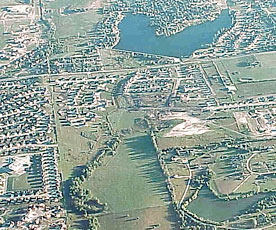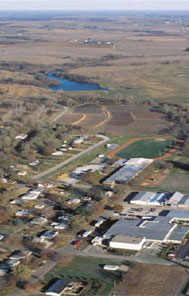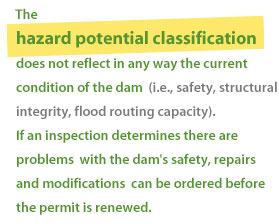About EAPs
What is a High-Hazard Potential Dam?
Each state has definitions and methods to determine the Hazard Potential of a dam. The Hazard Potential is defined as a situation which creates the potential for consequences such as loss of life, property damage, or other adverse impacts.
 Neighborhood association dams in suburban communities can be a significant risk to downstream residents and their homes, workers and their businesses, and even those who may be merely passing through the area.
Neighborhood association dams in suburban communities can be a significant risk to downstream residents and their homes, workers and their businesses, and even those who may be merely passing through the area.

Extensive development downstream from dams in rural areas will increase the risk to lives and property in the event of a dam failure.
These adverse impacts may occur in a defined area downstream of a dam because of flood-waters released through spillways and outlet works of the dam or because of waters released by partial or complete failure of the dam. Adverse impacts also may occur upstream of the dam from effects of backwater flooding or landslides around the reservoir perimeter.
In Kentucky, dams are regulated by the state if they are 25 feet or more in height and/or impound 50 acre-feet or more. Structures that fail to meet these criteria but have the potential to cause significant property damage or pose a threat to life in the downstream area are regulated in the same manner as dams. All such structures except federal dams and those permitted by the Division of Mine Reclamation and Enforcement must be reviewed, and a stream construction permit must be issued. The height of a dam is from the highest point on the crest of the dam to the lowest point on the downstream toe, and the storage capacity is the volume impounded at the elevation of the highest point on the crest of the dam. (See this website's glossary for further terms and definitions.)
Dam Safety Program engineers determine the "hazard potential" of a dam, meaning the probable damage that would occur if the structure failed, in terms of loss of human life and economic loss or environmental damage. Dams are assigned one of three classes based on the nature of their hazard potential:
- High Hazard (C) Structures located such that failure may cause loss of life or serious damage to houses, industrial or commercial buildings, important public utilities, main highways or major railroads.
- Moderate Hazard (B) Structures located such that failure may cause significant damage to property and project operation, but loss of human life is not envisioned.
- Low Hazard (A) Structures located such that failure would cause loss of the structure itself but little or no additional damage to other property. .
 The classification of dams can be changed if the hazard potential has changed. Flood plain zoning and early warning systems may be considered in making this determination. When dams are spaced so that the failure of an upper dam would likely cause failure of a lower dam ("cascading"), the consequence of the lower dam's failure determines the upper dam's hazard classification. In situations where a bridge or roadway is the only damageable property below a dam, hazard classification may be based on the possibility of loss of human life, indirect economic impact through loss of service, and direct cost of damage to the bridge or roadway.
The classification of dams can be changed if the hazard potential has changed. Flood plain zoning and early warning systems may be considered in making this determination. When dams are spaced so that the failure of an upper dam would likely cause failure of a lower dam ("cascading"), the consequence of the lower dam's failure determines the upper dam's hazard classification. In situations where a bridge or roadway is the only damageable property below a dam, hazard classification may be based on the possibility of loss of human life, indirect economic impact through loss of service, and direct cost of damage to the bridge or roadway.
The cost of dam repair and loss of services is included when calculating the economic loss estimate if the dam is a publicly owned utility, such as a municipal water supply dam.
Inspections, Exemptions, Laws and Regulations
Kentucky Revised Statutes 151.293, Section 6, authorizes the Energy and Environment Cabinet through the Kentucky Department of Environmental Protection to inspect existing structures that meet the definition of a dam. The Dam Safety and Floodplain Compliance Section of the Water Infrastructure Branch maintains a list of these structures in an inventory database. In determining the frequency of inspection of a particular dam, the cabinet takes into consideration the size and type, topography, geology, soil condition, hydrology, climate, use of the reservoir, the lands lying in the floodplain downstream and the hazard classification of the dam.
High- and moderate-hazard dams are inspected every two years. Low-hazard dams are inspected every five years. If the structure meets all the necessary requirements as outlined in Engineering Memorandum No. 5, a Certificate of Inspection is issued to the owner. Otherwise, the owner is notified of any deficiencies.
Staff with the Dam Safety Section and Floodplain Compliance Section periodically inspects all dams on the inventory as long as they continue to operate (approximately 300 dams each year). Each inspection starts with a complete file review in the office to note any identified deficiencies and to become familiar with hydrologic evaluations. The inspector then performs the field evaluation.
In the field, the inspector conducts a complete visual inspection. Surveys are completed for dams with missing measurements. Photographs help provide a permanent record of observations. Following the inspection, a letter and report are provided to the owner listing the observations and, if needed, deficiencies and remedial measures required. Enforcement action is sometimes required to ensure proper dam maintenance or modification.
The Dam Safety and Floodplain Compliance Section takes emergency action if a structure is in danger of failing and poses a threat to life or may cause serious property damage. The section is equipped with siphon pipes and pumps to help an owner drain water from a reservoir in an emergency. KRS 151.297 empowers the Energy and Environment Cabinet to take emergency action if an owner abandons a dam or refuses to take necessary action.
This same staff also processes between 100 and 200 floodplain compliance cases each year (see Floodplain Compliance).
Depending on the type of dam, periodic inspections are performed during the construction of a new dam. A final inspection is performed when the construction is complete and as-built drawings are submitted. If the dam is constructed according to the plans and specifications, a letter is issued approving the impounding of water. The dam is then added to the inventory database.
The fact that a dam does not fall within the inspection jurisdiction of the dam safety program does not mean it is safe. State dam safety regulators note that many of Kentucky's unregulated, private dams have gone unchecked for decades. Dams that are regularly inspectioned can erode over the years, or be damaged by floods. Some of these potentially hazardous dams are several miles from a downstream city that would be threatened by a failure.
Kentucky's water resources law is contained in Kentucky Revised Statutes Chapter 151, Geology and Water Resources. Originally enacted in 1966, the law was last amended in 1990. Regulations relating to dam safety are in Kentucky Administrative Regulations Chapter 4, Title 401, Water Resources.
Regulations relating to dam safety are in Kentucky Administrative Regulations Chapter 4, Title 401, Water Resources.
